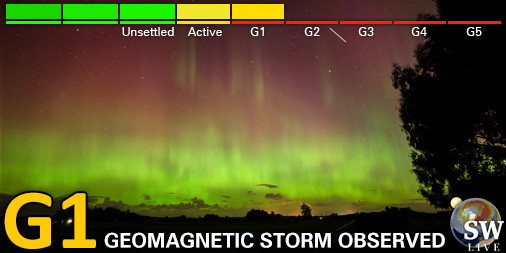Viewing archive of Saturday, 2 January 2016
Daily bulletin on solar and geomagnetic activity from the SIDC
Issued: 2016 Jan 02 1230 UTC
SIDC Forecast
Solar flares
C-class flares expected, (probability >=50%)
Geomagnetism
Active conditions expected (A>=20 or K=4)
Solar protons
Warning condition (activity levels expected to increase, but no numeric forecast given)
| 10cm flux | Ap | |
|---|---|---|
| 02 Jan 2016 | 098 | 020 |
| 03 Jan 2016 | 098 | 028 |
| 04 Jan 2016 | 100 | 021 |
Bulletin
Solar activity was moderate. NOAA AR 2473 produced a long duration M2.3 flare around midnight peaking at 00:11UT. It was associated with a dimming and radio sweeps and was responsible for an increase in the >10 MeV protons. An associated CME was detected in coronagraph data (see below). Two fairly insignificant regions have rotated onto the visible disk (now numbered NOAA 2476 and 2477). Meanwhile NOAA 2473, approaching the Western limb, remains the most probable source for flaring. Flaring at C level is expected with also a slight chance for an M flare. The >10 MeV proton flux values passed the event threshold of 10 pfu around 4:30UT, peaked at 21.5 pfu at 4:50UT and since decreased below the event threshold again. The warning condition for a proton event is maintained with NOAA AR 2473 still in the Western hemisphere. SoHO/LASCO C2 coronagraph data show a partial halo CME directed towards the South-West from 23:24UT January 1 onwards. The angular extent of the core is rather limited but counting the angular extent of the shock extensions it may be interpreted as about 200 degrees (CACTUS misinterpreted and overestimated the angular extent). Measured projected speeds are up to 1600 km/s. Given the limited angular extent of the core the CME seems directed mostly off the Sun-Earth line but a shock arrival at Earth in the afternoon of January 3 must be anticipated. No further CMEs were detected in coronagraph data. Solar wind conditions showed the recovery after the CME passage. Solar wind speed however saw a steady increase from around 420 km/s to around 490 km/s presently. Total magnetic field saw a peak of 10nT but is currently back at around 4 nT. Bz was variable and mostly above -5nT. Magnetic field phi angle was in the negative sector. Solar wind speed may further increase under the influence of a high speed stream from the extensions of the northern polar coronal hole and later, tomorrow afternoon, a shock arrival from the January 1/2 CME may be anticipated. Geomagnetic conditions were quiet to unsettled (both NOAA Kp and local K Dourbes 1-3). Geomagnetic conditions are likely to increase towards active or even minor geomagnetic storming under the influence of the high speed stream and expected shock arrival.
Today's estimated international sunspot number (ISN): 035, based on 06 stations.Solar indices for 01 Jan 2016
| Wolf number Catania | /// |
| 10cm solar flux | 098 |
| AK Chambon La Forêt | 021 |
| AK Wingst | 027 |
| Estimated Ap | 024 |
| Estimated international sunspot number | 033 - Based on 10 stations |
Noticeable events summary
| Day | Begin | Max | End | Loc | Strength | OP | 10cm | Catania/NOAA | Radio burst types |
|---|---|---|---|---|---|---|---|---|---|
| 01 | 2310 | 0011 | 0101 | ---- | M2.3 | --/2473 |
Provided by the Solar Influences Data analysis Center© - SIDC - Processed by SpaceWeatherLive
All times in UTC
Current data suggests there is a moderate possibility for aurora to appear at the following high latitude regions in the near future
Oulu, Rovaniemi, SodankyläKirkenes
Murmansk, Vorkuta
Luleå
Current data suggests there is a slight possibility for aurora to appear at the following high latitude regions in the near future
KuopioTrondheim
Arkhangelsk
Sundsvall, Umeå
Current data suggests there is a slight possibility for aurora to appear at the following middle latitude regions in the near future
TamperePetrozavodsk, Syktyvkar
Latest news
Latest forum messages
Support SpaceWeatherLive.com!
A lot of people come to SpaceWeatherLive to follow the Sun's activity or if there is aurora to be seen, but with more traffic comes higher server costs. Consider a donation if you enjoy SpaceWeatherLive so we can keep the website online!

Latest alerts
13:15 UTC - Geomagnetic activity
Minor G1 geomagnetic storm (Kp5) Threshold Reached: 13:07 UTC
12:33 UTC - Hemispheric Power Index
The OVATION model predicts the Hemispheric Power Index to reach 75GW at 13:21 UTC
00:15 UTC - Geomagnetic activity
Minor G1 geomagnetic storm (Kp5) Threshold Reached: 23:59 UTC
Thursday, 3 April 2025
20:15 UTC - Geomagnetic activity
Minor G1 geomagnetic storm (Kp5) Threshold Reached: 20:02 UTC
13:03 UTC - Hemispheric Power Index
The OVATION model predicts the Hemispheric Power Index to reach 50GW at 13:56 UTC
Space weather facts
| Last X-flare | 2025/03/28 | X1.1 |
| Last M-flare | 2025/04/01 | M2.5 |
| Last geomagnetic storm | 2025/03/27 | Kp5 (G1) |
| Spotless days | |
|---|---|
| Last spotless day | 2022/06/08 |
| Monthly mean Sunspot Number | |
|---|---|
| March 2025 | 134.2 -20.4 |
| April 2025 | 143 +8.8 |
| Last 30 days | 130.4 -16.1 |





